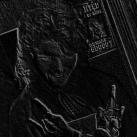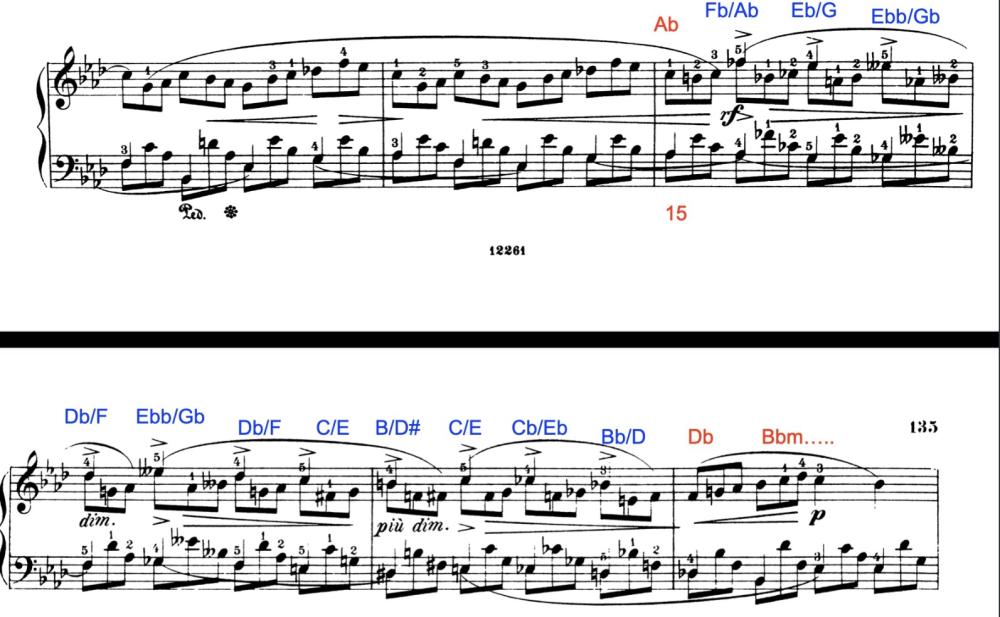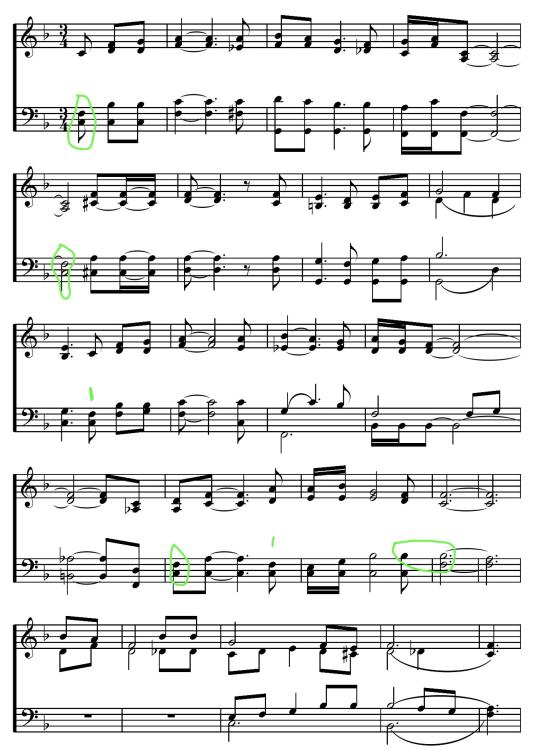Leaderboard
Popular Content
Showing content with the highest reputation on 01/25/2023 in all areas
-
Hi. First of all don't take my words literally, of course, do what you want. As far as I know, in 4 part writing, or generally speaking, since tonality became common, the fourth is a consonance if it is in the upper part of chord, that is, in first inversion (E - G - C). But when the fourth involves the bass, it is a dissonance. The 4th was used as the normal interval (together with the 5th) in times before the Renaissance (when the 3rd and the 6th were considered dissonances). On the other hand, Fauxbourdon, Faburden and Falsobordone are different harmonization and improvisatory techniques developed in the final part of the Middle Ages and the early Renaissance. They are techniques that harmonize a cantus firmus in three or four voices. Fauxbourdon has its origin in Bourgogne (France), Faburden in England, and Falsobordone in Italy. In these techniques the upper voice was strictly harmonized in the interval of 4th by the middle voice. These devices were used much more later, here you have an example of Fauxbourdon in the Impromptu Op. 29 by Chopin. As you can see, it is a sequence of chords in first inversion. Notice how in every of them the bass forms a third with the middle voice, and the middle a fourth with the upper voice . In your piece, some fourths involving the bass are in passing spots, or they seem prepared. But other ones are in strong places. As I said, you can do what you want. In my opinion, the fourths in this situation provides an "ancient" sound, and it is a bit incongruent with the piece following the tonal rules we all know.2 points
-
Haven't read everyone's feedback, sorry if I echo someone else. For one, if you're going to edit your piece and post the updates, make sure you edit your original post letting us know you did that. I didn't click every new version you gave us, so you might already know this, but just in case you didn't I thought I'd mention it. I almost didn't see it 🙂 - As a pianist, it's odd for me to see sections with just one staff. Even if you only need say the treble clef, I'd still put the bass clef in with rests. - How come you have 2 notes playing in the flute at times (or maybe other winds)? I don't recall a single moment when you gave us wind harmonies, why not just have the flute and oboe play together. I feel like it was a wasted opportunity to not hear some ideas with the instruments blended. With the type of piece this is, I'd think having solo wind instruments would be more beneficial than whole instrument groups. - Remember that the piano is polyphonic, and although I actually really enjoyed the mystical thin texture you gave us, there were plenty of moments that didn't really feel characteristic to the instrument. You do give us sections of both hands played at the same time, but overall it felt like I could have played the part with one hand. - The rhythms could have used some work, especially in the long whole note sections. Would have been a good time to explore a bit of counterpoint under sustained melodic lines. Again, I felt like the winds were underutilized. Just some random points, hopefully it helps you out a little. I really liked the language you used, and the harp-like vibes in the piano were really cool. Reminded me of traditional Japanese music. Like I said before, the sparse texture overall was VERY cool; I'm so used to people on this site cramming in a bunch of unnecessary notes in every measure of their works, and yours was a breath of fresh air. I'd love to hear any additions or edits you do with this piece in the future, I'm always a fan of hearing future versions in people's music to hear how it evolves and to see if they heeded the advice of others. There are loads of great composers here, be sure to at least consider some issues they had with your music. I've been on this site for years, and their advice has always benefitted me and I'm very grateful for it. Good luck with your music, and thanks for sharing!2 points
-
I just completed a piece for clarinet and piano. I would be very interested in getting your comments. There is probably still a need for some revision (spelling issues, slurring etc.). I am particularly interested to know about the potential playability of this piece. I am looking forward to your feedback!1 point
-
Hi guyyys, hear is my abomination of an action Theme. I only used free VSTs and I had to compress the file quite a bit, so the audio might suffer a bit. (Also sry if my English is bad, it´s not my native language.)1 point
-
Greetings Lord Dave, I think you're heading in the right direction, but the piece doesn't really suit a chase or action sequence. It more has a feel of being a theme like what you might find on the menu of a video game. The reason is that the music is too...well, thematic in its presentation. A good chase.action sequence involves a flurry of different, highly-rhythmic ideas, scale runs, trills, clever placement of dissonant harmonies, effects that aren't really possible with multiple samples (rips, shakes, overblown flutes, etc.) and frequent changes and often lots of stops and starts interlaced with tense transitions. The piece would also benefit, as Henry said, with more use of the other orchestral sections; namely brass stabs and wind runs. However, a lot of that can be difficult to convey with free samples I know1 point
-
Yes, important to recognise the linguistic properties of music - well, any sound really, linguistic being more appropriately applied to music than the many aural stimuli that assail us day and sometimes night, which nonetheless usually have some meaning. (It's about meaning which places it in the realm of semiotics.) But I can't agree that because atonal composers use the same 12 notes - in some ways the 'letters' of the alphabet, that they conform to a language - and certainly not the same language as the tonalists. Rather more comes into the tonal language - phrasing, the syntax, progression, intervals, rhythmic construction, dynamics, harmonic rhythm, selective repetition, all of which have been wired into our "minds" for a long time... which doesn't mean every event has to conform. Surprises - events outside the expected - are sometimes delightful, sometimes not. But it comes down to familiarity and expectation. Which comes down to communication and information theory. When I listen to a "verbal" programme I'd tune into one in English. I may not understand all the words, I may not agree with the presenter's viewpoint or have difficulty with concepts at the outset. But I can get the gist. I know enough of the language and am familiar with its delivery. Not so if it was transmitted in a language I can't speak - or an unfamiliar topic about which my vocabulary is non-existent. I might like the sound of it, sense musical outlines in the undulations of the voice but I wouldn't understand much of what was being said. Same with music that deviates too far from traditional tonality that the listener can no longer get the gist. It's where Schönberg fell flat. Thinking that he could create a new language which magically would be understood by a universal audience. Only Alban Berg who used the system at the time seemed to appreciate that music was the transmitter and the audience, the receiver. To me, Berg did the 'thinking through' at which Schönberg failed. Perhaps if Schönberg's ideas had been introduced more gently reception might have been different. And so with pure atonality (that which avoids key centres at all cost). It conforms to no musically linguistic patterns. It can have rules but in the absence of familiar linguistics it so far remains the province of individual composers. The listener basics are that one learns to listen without expectations. That isn't always easy. What the composer must do is provide means so that listeners have events on which to anchor, so they can reference what's happening at one moment to the next. Unlike serial music, atonal can be approached more gently - more tonal centres - tempi that allow acclimatisation - and gradually build on that. The acceptance of recent, chromatic music suggests that it is starting to enter listeners' repertoire so it's important not to shock them which will simply lead to dismissal.1 point
-
LOL I guess I am one of them!😎 I love the piano chords more in section C, since it's more varied! I love how you add more parts for the bassoon. It makes the texture thicker and supports the upper winds. Thanks for your update! Henry1 point
-
I don't understand that... As I have studied this, fauxbourdon technique consists in three voices: Cantus firmus in the upper one Middle voice at a fixed interval of a 4th from the upper voice Bass voice at a 6th from the upper one This results in a sequence of harmonies in first inversion.1 point
-
Thanks so much for listening and commenting. I'm a big fan of your work too btw! Have been trying to find a solution to this problem for months now. I want to compactify the score by omitting empty staves; but can't seem to make an exception for the piano part. Some of my other scores have the same issue. There are some menu options in MuseScore that should resolve the problem; but they don't seem to work. I made a new version of this piece yesterday (attached below). Another composer told me my harmonies were a bit boring in Section C, so I've tried to switch them up a bit. He didn't like that I was changing harmonies on the first note of every bar, and not straying far from the tonic. Also made some small rhythmic variations to break up the semibreve passages a little, and tweaked the bassoon part to make it slightly more interesting. Originally this was supposed to be for woodwind quartet and piano; but then I decided to make a sextet, with an extra flute and clarinet. For those passages with divisi flutes and clarinets, I thought it sounded better tonally than mixing instruments. My latest thinking is to reduce it back to a quartet; but haven't got round to that yet. Some of the piano runs are very difficult to play at tempo: so I decided to leave both hands free to cover all the notes. There are certainly places where I could add a part for the left hand; but I made an aesthetic choice to keep the piano part very simple and sparse. This was my first proper piece for GarageBand, and I noticed you could change the scale type for the on screen keyboard. So I thought it would be interesting to use scale changes instead of key changes to maintain interest. I start in the Japanese scale, then go to a minor blues scale, then a Kletzmer scale, then minor blues again, and back to Japanese at the end.1 point
-
Hi @GospelPiano12, Actually I don't think this is a simple SATB! There are many non harmonic notes, add notes and unusual chord progression in it! All I say may not be applicable here, since it's more a traditional SATB approach! In b.2 the G minor seventh chord with the F in alto is not too appropriate with a dominant seventh before and the F sharp in different voice. In b.3 there's crossing of voice between S and A. In b.4 the augmented chord with double leading tone of C sharp seems too dissonant for me. In b.6 the F following a B natural creates a tritone. In b.8 there's a parallel 8th btw S and B. The harmonic progression is not quite smooth overall but I don't know what is the crieteria of writing it, so I can't judge on that. Thanks for sharing! Henry1 point
-
1 point
-
Wise Nicholas. What is this BTW? I don't understand a thing, my limited brain cann...ot. Now on a more serious note, da beat is a bit typical but everything that surrounds it sounds kinda nice. Not my style, but a banger as that guy says. Good job. Kind regards, Daniel–Ømicrón.1 point







